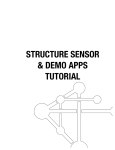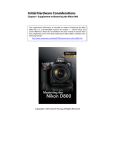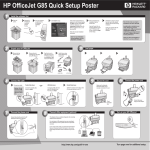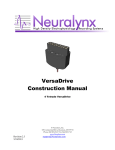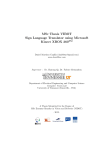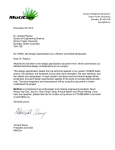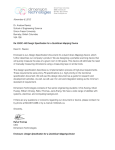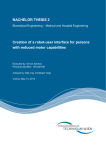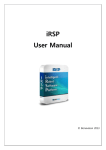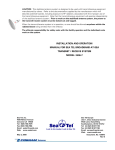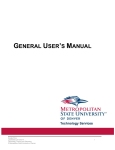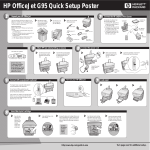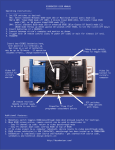Download STRUCTURE SENSOR QUICK START GUIDE
Transcript
STRUCTURE SENSOR QUICK START GUIDE 1 QUICK START GUIDE TABLE OF CONTENTS WELCOME TO YOUR NEW STRUCTURE SENSOR 2 WHAT’S INCLUDED IN THE BOX 2 CHARGING YOUR STRUCTURE SENSOR 3 CONNECTING YOUR STRUCTURE SENSOR TO YOUR IPAD 4 Attaching Structure Sensor to the bracket Attaching Structure Sensor and bracket to your iPad USING STRUCTURE SENSOR WITH A NON-iOS DEVICE USB Hacker Cable OpenNI Drivers USING YOUR STRUCTURE SENSOR FOR THE FIRST TIME 4 5 8 8 9 10 The Structure app Uplink Sample SDK Applications 10 14 19 MORE APPS ARE COMING SOON 28 ADDITIONAL HELP FOR STRUCTURE SENSOR USERS 28 FOLLOW OCCIPITAL AND THE STRUCTURE SENSOR 28 © 2014 Occipital, Inc. http://structure.io 2 QUICK START GUIDE WELCOME TO YOUR NEW STRUCTURE SENSOR Congrats on your new Structure Sensor! We’re sure you’re eager to start exploring your Structure Sensor’s capabilities. And to help you get the most out of your experience, we’ve put together this quick start guide to help familiarize you with this advanced accessory. WHAT’S INCLUDED IN THE BOX Your Structure Sensor should arrive with the following: • One Structure Sensor • One data cable with Apple Lightning connector • One AC battery charger • One screwdriver • Four M1.6 screws • One user manual © 2014 Occipital, Inc. http://structure.io 3 QUICK START GUIDE Your iPad attachment bracket will arrive in a separate box/package. CHARGING YOUR STRUCTURE SENSOR Charging your Structure Sensor’s internal battery is simple. Simply connect the supplied AC charger to the round port on the side of the Structure Sensor, and then plug the other end into any standard 2-pronged wall outlet as found in the United States (if you’re outside of the US or Canada, you will need to use an appropriate adaptor). An LED indicator on the Structure Sensor’s glass face will pulse when your Structure Sensor’s battery is charging. As soon as your battery is completely charged, the LED indicator will stop pulsing and instead will stay on until you disconnect the AC charger. © 2014 Occipital, Inc. http://structure.io 4 QUICK START GUIDE CONNECTING YOUR STRUCTURE SENSOR TO YOUR IPAD Step 1 – Attaching your Structure Sensor to the bracket Your Structure Sensor has arrived with one of three available brackets to connect it to different Apple iPad models (the currently available brackets are for the iPad [4th Generation], iPad Air and iPad mini with Retina display). Using the supplied screwdriver and 4 screws, attach the Structure Sensor to the supplied bracket. Place the Structure Sensor in front of the bracket, and then use the supplied screwdriver and 4 screws to attach the two together. The data and charging ports on the Structure Sensor should be facing to the left as you look at the Structure Sensor and bracket. The proper orientation for the Structure Sensor is to have the two data ports facing to the long side of the bracket. © 2014 Occipital, Inc. http://structure.io 5 QUICK START GUIDE Step 2 – Attaching the Structure Sensor and bracket to your iPad To attach the precision bracket with aluminum latch to your iPad, start by sliding the bracket plus Structure Sensor onto the top of your iPad, making sure that the aluminum latch is in its open position. Left: Sliding the bracket on an iPad (4th Gen). Right: The bracket firmly seated. Left: Sliding the bracket on an iPad (4th Gen). Right: The bracket firmly seated. The bracket’s iPad camera opening centered around the iPad camera. © 2014 Occipital, Inc. http://structure.io 6 QUICK START GUIDE As soon as the bracket is firmly seated on top of your iPad, and you have ensured that the hole in the bracket is centered around the iPad camera, close the latch by pressing down on it with your thumb. Step 3 – Attaching the Lightning cable to your Structure Sensor and iPad Connect the supplied Lightning cable by connecting it to your Structure Sensor first. The wide end of the cable connects to your Structure Sensor, and the goldcolored pins should be facing up as you press it firmly into the Structure Sensor. © 2014 Occipital, Inc. http://structure.io 7 QUICK START GUIDE Next, connect the other end of the cable with the Apple Lightning connector into your iPad. Your Structure Sensor is now fully charged and connected to your iPad! © 2014 Occipital, Inc. http://structure.io 8 QUICK START GUIDE USING STRUCTURE SENSOR WITH A NON-iOS DEVICE While the Structure Sensor has been carefully designed to work exceptionally well with iOS devices, it has also been designed to work with a wide range of other devices and platforms, including Android devices, and Windows, OS X and Android laptop and desktop PCs. To use the Structure Sensor with any of these alternative platforms, you will need the USB Hacker Cable as well as OpenNI drivers. USB Hacker Cable The USB Hacker Cable is included with Structure Sensor Hacker Kits and Complete Kits, and is an optional accessory for Structure Sensor iPad Kits. The Hacker Cable is much more than just a USB cable; it unlocks a number of capabilities already built in to your Structure Sensor. First and foremost, the Hacker Cable will allow the Structure Sensor to stream 3D data to compatible USB Host devices, such as select Android mobile devices and laptop/desktop machines using OS X, Windows or Linux operating systems. When connected to a compatible USB device, the Hacker Cable also lets the Structure Sensor: • Accept power for active use without using its internal battery • Accept charge to keep the Structure Sensor’s internal battery full © 2014 Occipital, Inc. http://structure.io 9 QUICK START GUIDE Finally, the USB Hacker Cable is truly…hackable. It can be lengthened, shortened or reterminated based on what you plan to use it for. The possibilities are endless! OpenNI Drivers The Structure Sensor is fully compatible with OpenNI 2 drivers for Android, Windows, OS X and Linux. More information on using the Structure Sensor with OpenNI 2 drivers can be found in the Structure Sensor and SDK Forums. Occipital now also hosts and actively maintains OpenNI 2 downloads and documentation at http://structure.io/OpenNI © 2014 Occipital, Inc. http://structure.io 10 QUICK START GUIDE USING YOUR STRUCTURE SENSOR FOR THE FIRST TIME The Structure App The Structure app is the first app for the Structure Sensor available on the App Store. Click here to download the Structure app. The Structure app includes a number of visualizations to show the raw data being captured and streamed by your Structure Sensor to your iPad. The first is the infrared feed being captured by the Structure Sensor’s infrared camera. To view this feed, connect your Structure Sensor to your iPad via the included Lightning cable, and then open the Structure app. Then, tap “IR” on the right hand menu. A view through the Structure Sensor’s infrared camera. In this mode, you can even use your Structure Sensor for night vision! © 2014 Occipital, Inc. http://structure.io 11 QUICK START GUIDE In the lower left hand corner, you’ll see a light bulb icon. Tap that icon to turn on the infrared LEDs to flood the scene with additional infrared light. The light bulb icon in the lower left hand corner illuminates the Structure Sensor’s two infrared LEDs for additional infrared lighting. The next visualization you can explore is the raw depth stream being captured by your Structure Sensor. Tap the “Depth” link in the right hand menu to view the depth stream. A view of the raw depth feed from the Structure Sensor. The circular target shows the distance between the Structure Sensor and objects closer than 4 meters. You’ll notice that there is a circular target with a measurement next to it. This is the exact distance from the Structure Sensor to the object that the target is covering. You can move your iPad to move the target, or you can tap the screen to move the target without moving the iPad. © 2014 Occipital, Inc. http://structure.io 12 QUICK START GUIDE The circular target has been moved from the bear (96.6cm away) to the banner (180.4cm away). Now that you’ve seen the depth stream, you can see it registered with the color images coming from your iPad’s megapixel camera. Tap the “Depth + Color” link in the right hand menu to see this. Note: The alignment between the depth and color images will be imperfect when you first receive your Structure Sensor. An over-the-air update will be sent to your Structure Sensor in the future to correct this. A view of the registered depth and color feeds from the Structure Sensor and the iPad. The Structure demo app also lets you update your firmware, as well as check the status of your Structure Sensor, including: serial number, firmware version © 2014 Occipital, Inc. http://structure.io 13 QUICK START GUIDE and battery charge. To check the status of your Structure Sensor, tap the “gear” icon in the lower right hand corner of your screen. Use the “gear” icon for a quick status check of your Structure Sensor, as well as for firmware updates. © 2014 Occipital, Inc. http://structure.io 14 QUICK START GUIDE Using Uplink with the Structure App The Structure app has an advanced feature called Uplink. Uplink lets you connect your Structure Sensor on an iPad wirelessly and in real-time to a Mac or Windows PC on the same wireless network. This allows you to stream data from the Structure Sensor to a PC running a desktop application, therefore taking advantage of the mobility of your iPad/Structure Sensor along with the greater computing power and memory of the PC. The Uplink menu option will only appear when a computer running an Uplink compatible program is on the same WiFi network as your Structure Sensor/iPad combination. When a PC with an Uplink-compatible program is on the same network as your iPad, you will see the Uplink option appear in the Structure app’s main navigation menu. Select the Uplink option in the menu to start streaming data from your Structure Sensor to the program running on the PC. Using Uplink with the Structure App and Skanect Right now, the first available Uplink-compatible program is Skanect. Skanect allows you to create, refine and share high-quality 3D models of objects and people captured with your Structure Sensor. To learn more about Skanect, visit the website here. If you backed us on Kickstarter and got a Structure Sensor, you should have received an email from us with your free Skanect Pro license because we hit our stretch goal! © 2014 Occipital, Inc. http://structure.io 15 QUICK START GUIDE While we won’t go into detail on how to get the best quality model using Skanect (we recommend visiting Skanect’s support page to watch their video tutorials for that), we will show you the basics of using Skanect in conjunction with the Structure app. To begin, you need to ensure that your iPad/Structure Sensor is on the same wireless network as the Mac or PC that is running Skanect. If they are not on the same network, then Uplink will not be enabled, and the two devices will be unable to communicate with each other. Next, open Skanect on your Mac or PC, and then click the “Record” tab. The “Record” tab is the second from the left. The tab will be highlighted in blue when selected, as shown at left. Now, you can select the “Uplink” menu option within the Structure app on your iPad. You’ll see that what is on your iPad’s screen is now mirrored in the Skanect interface: © 2014 Occipital, Inc. http://structure.io 16 QUICK START GUIDE The image on the iPad screen to the left is mirrored in real time on the Skanect interface above. Next, press the “Rec.” button in the upper left hand part of your iPad’s touchscreen to begin capturing an object or person in 3D. When your scan is complete, press the “Stop” button. © 2014 Occipital, Inc. http://structure.io 17 QUICK START GUIDE Just as before, what you see on your iPad’s screen will be mirrored in real time on your Mac or PC’s screen. © 2014 Occipital, Inc. http://structure.io 18 QUICK START GUIDE When your scan is complete and you have pressed stop, you will then be able to manipulate and process your completed scan using Skanect. Again, we recommend viewing the video tutorials at Skanect’s support page to learn how to use Skanect’s processing features in detail. © 2014 Occipital, Inc. http://structure.io 19 QUICK START GUIDE Sample SDK Applications If you are an iOS developer, these applications can be downloaded from the Structure Sensor and SDK forums at http://forums.structure.io. If you do not have access to the forums, email us at [email protected] to request access. Not an iOS developer but want to try the sample SDK apps on your iPad? As of June 10, 2014, we are in the process of submitting all of the sample SDK applications to the App Store and expect them to become available over the following 3 to 5 weeks. Using The “Viewer” Sample App The first demo app to try when you first attach your Structure Sensor to your iPad is the “Viewer” demo app. Viewer provides a simple view of what the Structure Sensor sees alongside what your iPad’s color camera sees. Here is what Viewer’s output looks like: The Structure Sensor’s depth feed is on the bottom left. A view of surface normals is on the right. The iPad’s color camera output is on top. © 2014 Occipital, Inc. http://structure.io 20 QUICK START GUIDE Using the Object Scanner Sample App In addition to using Uplink with Skanect, the Structure Sensor arrives with another option for those interested in 3D scanning. This is a simple 3D scanning app called “Object Scanner.” It’s easy to start getting great looking scans quickly and consistently if you learn just a few simple things about using this app. Finding Suitable Objects A great first test for the Object Scanner demo app is to try scanning another person from the shoulders up to the top of the head. The Object Scanner demo app works best for scanning objects the size of a medium-sized stuffed animal up to a human bust. Smaller items will lack detail and may challenge object tracking. Larger objects may be difficult to capture in their entirety. The Object Scanner demo app may have difficulty capturing black surfaces and shiny surfaces. In addition, the Object Scanner demo app will have difficulty capturing intricate features, such as hairs, wires or other fine objects. Setting Up Objects To Scan For the best quality scan, please follow these general guidelines: • Stand about 1 meter (or 3 feet) away from the object or the person • Make sure that you have an unimpeded 360-degree path around the object or person so that you may capture an entire scan easily • For objects, placing them at a standard tabletop height allows for the best combination of scanning quality and ease • For objects, placing them on a smooth, flat surface ensures that the Object Scanner demo app will consistently capture great scans • The Structure Sensor works best indoors or outside of direct sunlight © 2014 Occipital, Inc. http://structure.io 21 QUICK START GUIDE Positioning the Scan Area Cube When you first open the Object Scanner demo app and connect your Structure Sensor to your iPad, you will see a large transparent cube appear on your screen. The bottom of this cube has an orange square. The orange square will automatically snap itself to flat surfaces such as floors or walls so that your scan is positioned on a flat plane. Alternatively, if you point the Structure Sensor towards a person, the transparent cube will position itself around their upper torso and head for a bust scan. The transparent cube and orange square determine what objects or people the Object Scanner demo app will capture. © 2014 Occipital, Inc. http://structure.io 22 QUICK START GUIDE To scan an object, start by standing about a meter (about 3’) away from the object. Then, center the object within the transparent cube. Once the object is within the cube, you will see that the orange square will now adjust itself to fit over the object you plan to scan. When placed on an object or person, the transparent cube and orange square show what will be captured once the blue “Scan” button is pressed. If parts of the object you plan to scan are not covered in orange, you are standing too close. Back up until those parts are covered. In this picture, the Structure Sensor is too close to the subject to be scanned, as it does not fit entirely in the transparent cube. © 2014 Occipital, Inc. http://structure.io 23 QUICK START GUIDE Using the “Pinch” Gesture Because the cube determines what will be captured by the Object Scanner demo, it is important to make sure the cube is the right size for the object to be scanned. The size of the transparent cube can be easily adjusted using the typical iPad “pinch” gesture. Push your thumbs together on your iPad screen to make the cube smaller, and pull them apart to make it bigger. If the cube is too small to contain the object you plan to scan, you can expand the cube by pulling your thumbs apart on your iPad screen. You may also try to move backwards so that you are further from the object you plan to scan. Although the Structure Sensor is a reasonable distance away from the object to be scanned, the scan area cube is too small. Put both thumbs on the touch screen and move them apart to make the scan area cube larger. © 2014 Occipital, Inc. http://structure.io 24 QUICK START GUIDE If the cube is too large for the object you plan to scan, then your scan will be of poor quality and you may potentially capture objects in your scan that you do not want. You can shrink the cube by pushing your thumbs together on your iPad screen. You may also try to move closer so that you are nearer to the object you plan to scan. Although the Structure Sensor is a reasonable distance away from the object to be scanned, the scan area cube is too large. Put both thumbs on the touch screen and move them together to make the scan area cube smaller. For the highest quality scans, pinch to shrink the cube so it is just a bit bigger than the object within it that you plan to scan. The size of the scan area cube is just about right to begin scanning this teddy bear. © 2014 Occipital, Inc. http://structure.io 25 QUICK START GUIDE Scanning the Object To begin your scan, press the blue “Scan” button. Once you have started, move around the object to capture it. If you notice that there is a hole in the model, you can go back during the same scan to see if the Object Scanner demo app can fill it in. If you have made a mistake during your scan, you can press the red reset button with the circular arrow on it to restart your scan. Click the “Done” button when your scan is complete. As soon as you start scanning, you will see your 3D model appearing on top of your subject in real time. As you continue your scan, you can go back and fill in holes and other problem areas to improve your 3D model. © 2014 Occipital, Inc. http://structure.io 26 QUICK START GUIDE Maintaining Tracking On your first few scans, you may notice that the Object Scanner demo app loses track of the object. A warning note will appear on your screen: On rare occasions, the Object Scanner demo app will lose tracking of the object or person you are scanning. You will see this error message if that happens. Try to rematch the scan to the object you are scanning to restart object tracking. If that doesn’t work, try your scan again. If you consistently get object tracking errors during a scan of the same object, that object may not be suitable for scanning. © 2014 Occipital, Inc. http://structure.io 27 QUICK START GUIDE Viewing Your Completed Scan To view your scan, click the “done” button. A review screen will appear. You can use your finger to drag the model around to see all sides of it. Once you click the “Done” button, you will automatically be taken to this screen. Use your finger to drag the model around to see it from all angles. You can also click “X-Ray View” to see the underlying mesh of the model that you have captured. When you click the “XRay View” button, the underlying mesh will appear. Click the “Email” link in the upper right hand corner to export an .OBJ file. To share or export a scan, click the “email” link in the upper right hand corner. Click this to email an .OBJ file of your scan to yourself or a friend. Click the “Back” link to reset the app so you can start your next scan. © 2014 Occipital, Inc. http://structure.io 28 QUICK START GUIDE MORE APPS ARE COMING SOON! At Occipital, we’re planning on releasing more sample apps to expand the functionality of your Structure Sensor. In addition, developers worldwide are now using the Structure SDK to create more great apps, too. We’ll be sure to keep you posted whenever new sample apps are available for your Structure Sensor. And, if you’re a developer, we’re always here to help you build your own great app for the Structure Sensor! NEED MORE HELP USING YOUR STRUCTURE SENSOR? We’re always ready to help answer any questions or comments you might have about your Structure Sensor. Contact us at [email protected] anytime! If you’re developing an application using the Structure SDK or open source drivers, please join the Structure Developers’ Forum at http://forums.structure.io for assistance. FOLLOW OCCIPITAL AND THE STRUCTURE SENSOR On Twitter http://twitter.com/structure http://twitter.com/occipital On Facebook http://facebook.com/structure3d http://facebook.com/occipital On YouTube http://youtube.com/occipitalhq On the Internet http://structure.io and http://structure.io/developers http://occipital.com © 2014 Occipital, Inc. http://structure.io





























